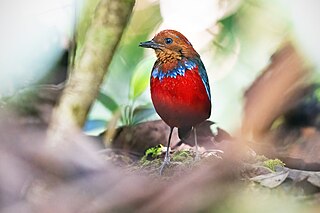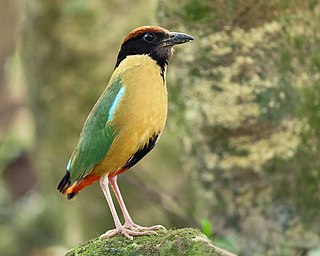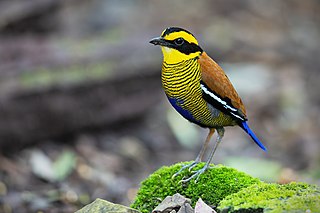
Pittas are a family, Pittidae, of passerine birds found in Asia, Australasia and Africa. There are 44 species of pittas, all similar in general appearance and habits. The pittas are Old World suboscines, and their closest relatives among other birds are in the genera Smithornis and Calyptomena. Initially placed in a single genus, as of 2009 they have been split into three genera: Pitta, Erythropitta and Hydrornis. Pittas are medium-sized by passerine standards, at 15 to 25 cm (5.9–9.8 in) in length, and stocky, with strong, longish legs and long feet. They have very short tails and stout, slightly decurved bills. Many have brightly coloured plumage.

Bulwer's pheasant, also known as Bulwer's wattled pheasant, the wattled pheasant or the white-tailed wattled pheasant, is a Southeast Asian bird in the family Phasianidae endemic to the forests of Borneo. It is currently listed as Vulnerable by the IUCN.

The rainbow pitta is a small passerine bird in the pitta family, Pittidae, endemic to northern Australia, most closely related to the superb pitta of Manus Island. It has a velvet black head with chestnut stripes above the eyes, olive green upper parts, black underparts, a bright red belly and an olive green tail. An Australian endemic, it lives in the monsoon forests and in some drier eucalypt forests.

The montane racket-tail or the Luzon racket-tail, is a species of parrot in the family Psittaculidae. It was previously conspecific with the Mindanao racket-tail. It is endemic to the mountains of northern Luzon in the Philippines. It is threatened by habitat loss and the cage bird trade.

Hose's broadbill is a species of bird in the family Calyptomenidae. It was described by the British naturalist Richard Bowdler Sharpe in 1892 and is named after the British zoologist Charles Hose, who collected the holotype of the species. It is 19–21 cm (7.5–8.3 in) long, with females weighing 92 g (3.2 oz) on average and males weighing 102–115 g (3.6–4.1 oz). Males are bright green and have conspicuous black spots on the wings, black markings on the head, blue underparts, black flight feathers, and a large green tuft covering most of the bill. Females have smaller forehead tufts, lime-green underparts with sky blue instead of azure blue on the undertail coverts, and lack black markings on the head, except for a black spot in front of the eye.

The blue-banded pitta is a species of bird in the family Pittidae. It is endemic to the island of Borneo, where it is found in all three countries that share the island: Malaysia, Brunei and Indonesia. Its natural habitat is subtropical or tropical moist lowland forest.

The blue pitta is a species of bird in the family Pittidae found in the northeastern Indian subcontinent, southern China, and Indochina. It typically lives in moist forests but can also inhabit dry forest. It is an unobtrusive, solitary bird which feeds by foraging on the ground for insects and other small invertebrates.

The garnet pitta is a species of bird in the family Pittidae. It is found in Brunei, Indonesia, Malaysia, Myanmar, Singapore, and Thailand. Its natural habitat is subtropical or tropical moist lowland forest. It is threatened by habitat loss. The form occurring in the Malaysian state of Sabah has been split as the black-crowned pitta.
The whiskered pitta is a rare species of bird in the family Pittidae. It is endemic to Luzon in the Philippines. This bird is the largest pitta in the country reaching 23 cm long and 116 g in mass. It has a brownish head, blue breast, and red belly. It has broad ash malar or "whiskers". Its natural habitat is tropical moist lowland forest and tropical moist montane forest. It is threatened by habitat loss and trapping. It is one of the most sought after birds by birdwatchers in the Philippines.

The blue-winged pitta is a passerine bird in the family Pittidae. It forms a superspecies with three other pittas, the Indian pitta, the fairy pitta and the mangrove pitta. A colourful bird, it has a black head with a buff stripe above the eye, a white collar, greenish upper parts, blue wings, buff underparts and a reddish vent area. Its range extends from India to Malaysia, Indonesia, southern China and the Philippines. Its habitat is moist woodland, parks and gardens and it avoids dense forest. It feeds mainly on insects and worms. It breeds in the spring, building an untidy spherical nest on the ground, often near water and between tree roots. A clutch of about five eggs is laid and incubated by both parents, hatching after about sixteen days.

The blue-naped pitta is a species of bird in the family Pittidae.

The azure-breasted pitta is a species of bird in the family Pittidae. It is a striking and colorful bird having colors of red, azure, green, black and white, It is endemic to the islands of Mindanao, Bohol, Leyte and Samar in the Philippines. Its natural habitat is tropical moist lowland forest. It is threatened by habitat loss.

The noisy pitta is a species of bird in the family Pittidae. The noisy pitta is found in eastern Australia and southern New Guinea. It eats earthworms, insects and snails. Its natural habitats are temperate forests, subtropical or tropical moist lowland forest, and subtropical or tropical moist montane forest.

The golden-naped barbet is a member of the family Megalaimidae. It is found in Indonesia and Malaysia, where it is endemic to the island of Borneo. Its natural habitats are subtropical or tropical moist lowland forest and subtropical or tropical moist montane forest.

Whitehead's trogon is a species of bird in the family Trogonidae. It is endemic to the island of Borneo, where it is an uncommon resident in primary mountain forest. One of Borneo's largest trogons at 29 to 33 cm long, it is sexually dimorphic. The male is crimson on the head, nape, and underparts, with a black throat and grey chest; the rest of his upperparts are cinnamon-coloured. The female is similarly patterned, but cinnamon-brown where the male is scarlet. The species was first described for science by Richard Bowdler Sharpe in 1888, who named it for British explorer and collector John Whitehead. There are no subspecies.

The Bornean treepie is a passerine bird belonging to the treepies genus, Dendrocitta, of in the crow family, Corvidae. It is endemic to the island of Borneo. It is sometimes treated as a subspecies of the Sumatran treepie.

The black-crowned pitta, also known as the black-headed pitta, black-and-crimson pitta, black-and-scarlet pitta or black-crowned garnet pitta, is a brightly coloured, ground-dwelling, bird species in the pitta family. It is endemic to the Southeast Asian island of Borneo. It was described by John Gould in 1877, with the type locality recorded as the Lawas River in northern Sarawak.

The Dulit partridge, also known as Hose's partridge, has been considered a distinctive subspecies of the long-billed partridge, a bird in the Phasianidae, or pheasant, family. It is endemic to Borneo, where it appears to be separated altitudinally from the nominate subspecies, and is often considered now to be a full species, Rhizothera dulitensis. It is little-known, rare, and has not been recorded since 1937.

The Bornean banded pitta is a species of bird in the family Pittidae. It is found only in Borneo. It was formerly considered conspecific with the Javan and Malayan banded pittas. Together, they were referenced as the banded pitta.

The Malayan banded pitta is a species of bird in the family Pittidae. Other common names include the blue-tailed pitta, the Irene's pitta, the banded pitta and the Van den Bosch's pitta. It is found in Thailand, the Malay Peninsula and Sumatra. It was formerly considered conspecific with the Bornean and Javan banded pittas, together they were referred to as the banded pitta, but now they are considered to be separate species.






















